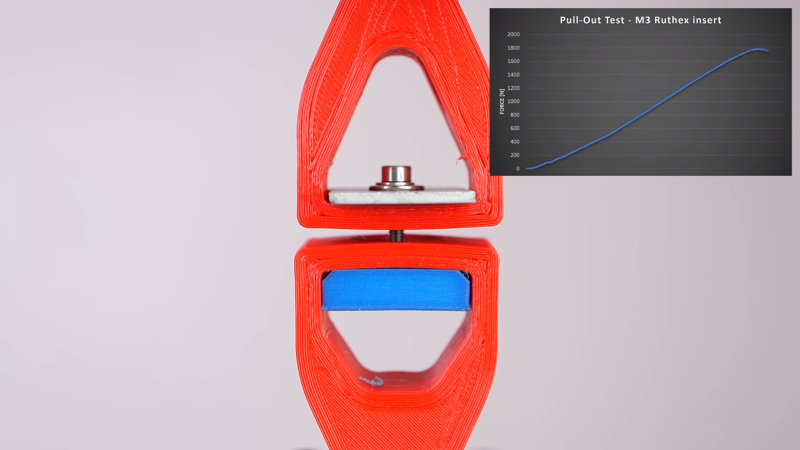Have you ever wondered whether it’s worth the time and expense to install threaded inserts into your 3D-printed projects? [Stefan] from CNC Kitchen did, and decided to answer the question once and for all, with science.
If this sounds familiar, it’s with good reason: we covered [Stefan]’s last stab at assessing threaded inserts back in March. Then, he was primarily interested in determining if threaded inserts are better than threads cut or printed directly into parts. The current work is concerned with the relative value of different designs of threaded inserts. He looked at three different styles of press-in inserts, ranging in price from pennies apiece to a princely 25 cents. The complexity of the outside knurling seems not to be correlated with the price; the inserts with opposed helical knurls seem like they’d be harder to manufacture than the ones with simple barbs on the outside of the barrel, but cost less. And in fact, the mid-price insert outperformed the expensive one in pull-out tests. Surprisingly, the cheapest inserts were actually far worse at pull-out resistance than printing undersized holes and threading an M3 screw directly into the plastic.
[Stefan] also looked at torque resistance, and found no substantial difference between the three insert types. Indeed, none of the inserts proved to be the weak point, as the failure mode of all the torque tests was the M3 bolt itself. This didn’t hold with the bolt threaded directly into the plastic, of course; any insert is better than none for torque resistance.
We enjoyed seeing [Stefan]’s tests, and appreciate the data that can help us be informed consumers. [John] over at Project Farm does similar head-to-head tests, like this test of different epoxy adhesives.
Thanks to [MLewis] for the tip.

















While we’re talking head to head tests, no love for Matthias Wandel’s Gorilla glue vs. wood glue shootout (https://www.youtube.com/watch?v=MUWu-N85oXM) and pocket hole vs. mortise and tenon joint comparison (https://www.youtube.com/watch?v=apsH8eBfjVA)?
Love pretty much everything Matthias does, but AFAIK we haven’t covered them on Hackaday. That was probably an oversight.
I can’t watch the video right now bit this bit throws up a question in my mind:
“Surprisingly, the cheapest inserts were actually far worse at pull-out resistance than printing undersized holes and threading an M3 screw directly into the plastic.”
Not that surprising given the design, but that’s at the first time you tread the M3 screw in. What happens after you do it 10 times? Maybe the insert is better at that point than not having it?
Even chinesium is better than plastics in handling repeated tightening. Self taping screws are used when that’s not an issue.
Stefan does remark that on his video, saying that if you are going to bolt-and-forget an undersized hole on the print is good enough, and that if you are going to constantly insert and remove the screws even the cheap insert is a better option.
I’d actually like to see what happens when yo try to pull the threaded insert out the other way – in the opposite direction from how they’re inserted. I’d imagine the plastic would break before the insert pulls out, depending on how much plastic is backing it up and the diameter of the clearance hole needed to pass the fastener. Not suitable for every application, of course, but I’d bet it would be pretty strong.
There are so many things wrong with this video.
1.Inserts are to be molded in when the plastic is injection molded.
2.Inserts are installed ultrasonically, not with a soldering iron
3. inserts are to to be pulled from the opposite side of the material.
If your snapping the heads off of the fasteners you are over torquing the product.
( torque for that size screw is in the neighborhood of 5 inch pounds )
I was of the impression ultrasonic welding just melted the plastic anyway?
Not everyone has easy access to an ultrasonic welder OR injection moulding.
And by far the majority of the time the intended use case is for the force to be pulling the insert out in the normal direction (eg. you’ve printed an enclosure with a lid) as these test results are intended for the average maker.
Horses for courses. Maker videos are intended to help the maker community make *their* stuff better.
I would love to see a more advanced video if you’re willing to make one :)
I would have liked to have seen a captive nut compared alongside.
Same. Captive nut is the status quo at my workbench that progress has to be compared with.
Same here. A captured nut or embedded in the opposite side of insertion. Bolt might fail first at that point
This probably isn’t groundbreaking or anything, but for small screws I’ve had good luck pre-heating them with a soldering iron, then run it in and out of the part to form the thread. The thread forms a little nicer than just forcing the plastic around and potentially separating along the layer lines.
If you like this kind of testing, also check out the “ProjectFarm” channel on Youtube.
I’d like to see tests with embedded sliding and/or pronged t-nuts. I suspect that they would work much better to resist both pulling and torque.